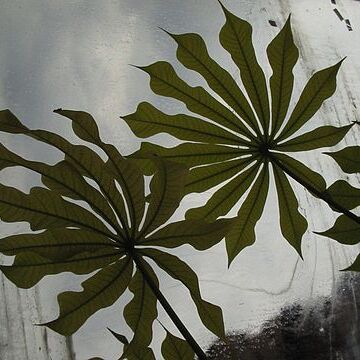Usually glaucescent and ± pruinose monoecious laticiferous shrubs or trees, rarely herbs. Leaves alternate, simple, peltate or not, entire or more usually deeply 3–11-palmatilobed to-palmatipartite, the lobes entire or themselves lobulate, petiolate or rarely sessile; stipules small or large, sometimes leafy. Inflorescences racemose or paniculate, terminal or axillary in the uppermost leaf-axils, generally composed of 1 or more long-pedicellate basal ♀ flowers and several short-pedicellate ♂ flowers; bracts small or large, sometimes leafy, entire or laciniate. Male flowers large; calyx campanulate or tubular, 5-lobed, often pigmented, with the lobes imbricate or contorted; petals 0; stamens 10, in 2 whorls, free, inserted between the lobes or glands of the disc; anthers dorsifixed, dehiscing longitudinally; pistillode, when present, small, trifid, in the middle of the disc. Female flowers large; calyx as in the ♂ flowers; petals 0; disc hypogynous, entire or lobed; ovary trilocular, smooth or longitudinally winged; 1 ovule per locule; styles shortly connate at the base, variously dilated and lobed. Fruits septicidally dehiscent into 3 bivalved cocci, smooth or longitudinally winged. Seeds carunculate; testa crustaceous; albumen fleshy; cotyledons flat, broad.
Shrubs or trees, evergreen, perennial, monoecious; stems and foliage with watery-white latex. Indumentum of simple trichomes, glandular trichomes absent, stinging trichomes absent. Stipules entire, conspicuous or inconspicuous, deciduous. Leaves alternate, petiolate, elobate or usually deeply 3–11-palmatilobed to palmatipartite, entire, palminerved; glands absent. Inflorescences terminal or axillary, racemose or paniculate, solitary, bisexual and androgynous, with flowers in bracteate clusters. Male flowers pedicellate; calyx lobes 5, imbricate, long connate; petals absent; disc of free lobes; stamens 10, filaments free and biseriate; anthers dorsifixed, bilobate, thecae oblong and longitudinally dehiscent; pistillodes present. Female flowers pedicellate; calyx lobes 5, imbricate, long connate; petals absent; disc hypogynous, entire or lobed; ovary 3-locular, ovules uniloculate; styles shortly connate at base, simple. Fruit capsular, trilobate, surface smooth, dehiscing septicidally into 3 bivalved cocci. Seeds subglobose to ellipsoid; testa crustaceous; albumen fleshy; caruncles entire, non-arilloid; cotyledons broad, flat.
Herbs, subshrubs, shrubs, or trees, perennial, unarmed, usually monoecious, rarely dioecious; hairs unbranched or absent; latex white. Leaves persistent or deciduous, alternate, simple [palmately compound]; stipules present, deciduous; petiole present [rudimentary], glands absent; stipels present at apex; blade usually palmately lobed, rarely unlobed, lobes undivided or secondarily lobed, margins entire, repand, or serrate, laminar glands absent; venation palmate (pinnate in lobes). Inflorescences bisexual (pistillate flowers proximal, staminate distal), terminal or axillary, racemes or panicles; glands subtending each bract 0. Pedicels present, pistillate often elongating in fruit. Staminate flowers: sepals 5, petaloid, 7–20 mm, valvate, connate 1/2 length; petals 0; nectary intrastaminal, cushion-shaped, lobed; stamens (6–8)–10, in 2 whorls, distinct; pistillode absent. Pistillate flowers: sepals 5, petaloid, distinct; petals 0; nectary annular, lobed or unlobed; pistil 3-carpellate; styles 3, connate basally, unbranched, flabellate, prominently papillate. Fruits capsules. Seeds globose to oblong; caruncle present. x = 9.
Trees, shrubs, or herbs, monoecious (rarely dioecious), sometimes with fleshy root-tubers; stems and branches with prominently large leaf scars; latex white; indumentum absent. Leaves alternate; stipules small, usually caducous; petioles long, apex glandular or stipellate; leaf blade usually palmately lobed or dissected, sometimes uppermost subentire. Inflorescences terminal or pseudoaxillary, mostly racemose-paniculate, usually bisexual, with long peduncles; flowers apetalous. Male flowers: calyx synsepalous; sepals 5, imbricate, petaloid; disk intrastaminal, usually 10-lobed; stamens 8-15, in 2 series; filaments free, delicate; anthers 2-locular, longitudinally dehiscent, connectives hairy at apex; pistillode small or absent. Female flowers: sepals 5, free or connate, sometimes deciduous; disk annular, sometimes with staminodes; ovary 3(or 5)-locular; ovules 1 per locule; styles short, free, mostly multifid or lacerate (rarely bifid); stigmas broad. Fruit a capsule, 3-valved; columella often persistent. Seeds carunculate; testa dry, crustaceous; endosperm fleshy; cotyledon broad and flat.
Male flowers pedicellate; buds ovoid, ellipsoid or fusiform; calyx campanulate or tubular, 5-lobed, the lobes imbricate or contorted, often pigmented; petals absent; disk deeply lobed or consisting of separate glands; stamens 10, biverticillate, free, inserted between the lobes or glands of the disk; anthers dorsifixed, longitudinally dehiscent; pistillode small, trifid, or absent.
Female flowers long-pedicellate; tepals 5, free, imbricate, caducous; petals absent; disk entire or lobulate, pigmented; ovary 3-locular with 1 ovule per loculus; styles 3, short, connate at the base, often dilated or lobed.
Leaves alternate, petiolate, stipulate, simple, sometimes peltate, entire or more usually deeply palmately 3–11-lobed or-partite; the lobes entire or lobulate, penninerved.
Inflorescences terminal, rarely axillary, racemose or paniculate, bisexual with 1–few female flowers and several male flowers; bracts sometimes foliaceous.
Fruits subglobose, ± smooth or longitudinally 6-winged, dehiscing septicidally into 3 bivalved cocci; endocarp woody; columella persistent.
Monoecious often glaucous and pruinose laticiferous trees or shrubs, rarely herbs.
Seeds carunculate; testa crustaceous; albumen fleshy; cotyledons broad, flat.
Indumentum, when present, simple.

